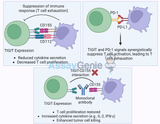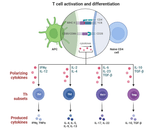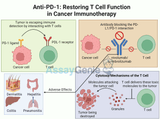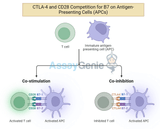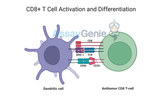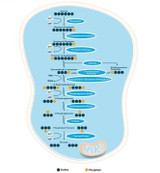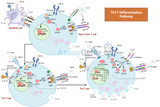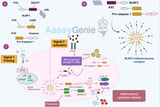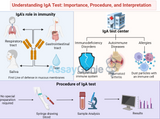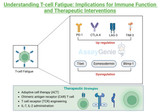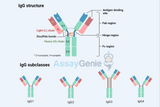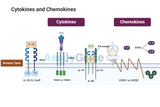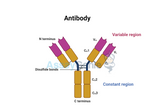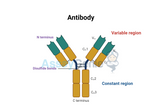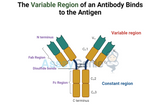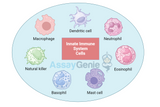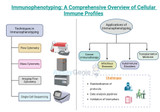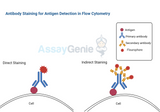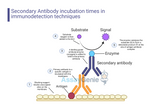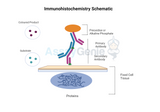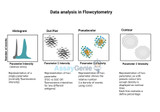Blog
TIGIT: A New Frontier in Cancer and Autoimmune Disease Immunotherapy
TIGIT (T cell immunoreceptor with Ig and ITIM domains) has emerged as a promising target in cancer immunotherapy and the treatment of autoimmune diseases. As a checkpoint receptor, TIGIT plays a critical role in regulating immune responses by inhibiting the activity of immune cells, especially T cells and natural killer (NK) cells. By manipulating TIGIT pathways, scientists aim to develop therapies that enhance immune responses against cancer or dampen harmful immune activity in autoimmune disorders.Understanding TIGIT's Role in Immune RegulationTIGIT belongs to the immunoglobulin superfamily and is primarily expressed on T cells, including regulatory T cells (Tregs), activated
…
1st Oct 2024
CD4+ T Cells: Unveiling the Role of Helper and Regulatory T Cells
CD4+ T cells are central to the immune system, functioning as coordinators of immune responses and regulators of immune tolerance. These cells are divided into two primary subtypes: Helper T cells (Th cells) and Regulatory T cells (Tregs). Both subsets of CD4+ T cells perform distinct roles, influencing the immune system's ability to attack pathogens or suppress excessive immune activity. Understanding the specialized functions of these cells sheds light on their importance in diseases such as infections, autoimmune disorders, and cancer.Assay Genie · CD4+ T Cells Unveiling The Role Of Helper And Regulatory T CellsCD4+ T Cells: Structure and DifferentiationCD4+ T cells are a sub
…
25th Sep 2024
Anti-PD-1: Restoring T Cell Function in Cancer Immunotherapy
Cancer immunotherapy has revolutionized the treatment landscape for various malignancies. One of the most promising therapeutic strategies is the use of immune checkpoint inhibitors, particularly anti-PD-1 (programmed death-1) antibodies. These drugs enhance the immune system's ability to recognize and destroy cancer cells by restoring the function of T cells, which are often suppressed in cancer patients.Assay Genie · Anti-PD-1: Restoring T Cell Function in Cancer ImmunotherapyIntroduction to PD-1 and Its Role in Immune EvasionPD-1 is an immune checkpoint receptor expressed on T cells. It plays a critical role in maintaining immune homeostasis by preventing overactivation of T
…
24th Sep 2024
Anti-CTLA-4: Unleashing the Power of T Cells in Combination Immunotherapy
Immunotherapy has revolutionized cancer treatment by harnessing the body's immune system to fight malignancies. Among the notable advancements in this field is the development of immune checkpoint inhibitors. One of the key players is anti-CTLA-4 (cytotoxic T-lymphocyte-associated protein 4), a monoclonal antibody that disrupts immune checkpoints and enhances T cell activation. Anti-CTLA-4 has shown immense promise, especially when used in combination immunotherapy. This article delves into how anti-CTLA-4 works, its role in unleashing the power of T cells, and its synergistic effects in combination therapies.Assay Genie · Anti - CTLA - 4 Unleashing The Power Of T Cells In Combi
…
24th Sep 2024
CD8+ T Cells: Understanding the Role of Cytotoxic T Cells in Immunity
CD8+ T cells, also known as cytotoxic T lymphocytes (CTLs), are a critical component of the immune system. They play a vital role in defending the body against viral infections, intracellular pathogens, and tumor cells. This article will delve into the biology of CD8+ T cells, their mechanisms of action, and their clinical relevance, particularly in immunotherapy and infectious disease control.Assay Genie · CD8+ T Cells Understanding The Role Of Cytotoxic T Cells In ImmunityWhat Are CD8+ T Cells?CD8+ T cells are a subset of T lymphocytes that express the CD8 glycoprotein on their surface. This marker distinguishes them from other T cells, such as CD4+ helper T cells. CD8+ T cell
…
23rd Sep 2024
Anti-PD-L1: Targeting Tumor Evasion with Immune Checkpoint Blockade
IntroductionCancer cells have developed sophisticated mechanisms to evade the immune system, particularly through the inhibition of T-cell responses. One such mechanism involves the programmed death-ligand 1 (PD-L1), which binds to its receptor PD-1 on T cells, leading to the suppression of immune activity. Anti-PD-L1 therapies, as part of the broader category of immune checkpoint inhibitors, have transformed cancer treatment by restoring immune system function and enhancing the body's ability to recognize and eliminate tumor cells. This article explores the role of PD-L1 in immune evasion and how its inhibition can significantly impact cancer therapy outcomes.Assay Genie · Anti
…
22nd Sep 2024
Biological Role of GLP-1
Glucagon-like peptide-1 (GLP-1) is a critical hormone in the regulation of glucose metabolism and has garnered significant attention due to its therapeutic potential in managing diabetes and obesity. Understanding the biological role of GLP-1 provides insights into its mechanisms of action and its impact on various physiological processes.Introduction to GLP-1GLP-1 is an incretin hormone primarily produced in the L-cells of the small intestine in response to food intake. It plays a pivotal role in enhancing insulin secretion from the pancreas, a process crucial for maintaining glucose homeostasis. GLP-1 is derived from the proglucagon gene and exists in two main forms, GLP-1(7-3
…
20th Jun 2024
Th17 Cell Differentiation: Insights into Immunological Dynamics
Th17 cells, a subset of T helper cells characterized by their production of interleukin-17 (IL-17), play a significant role in the immune system's response to pathogens and in the pathology of autoimmune diseases. This article delves into the mechanisms of Th17 cell differentiation, exploring the interplay of cytokines, transcription factors, and their implications for health and disease. Initiation of Th17 Differentiation: The Cytokine Prelude The Role of TGF-β and IL-6 Th17 differentiation begins with the orchestration of specific cytokines, notably transforming growth factor-beta (TGF-β) and interleukin-6 (IL-6). TGF-β sets the stage for a bifurcated pathway t
…
25th May 2024
Inflammasome Activation Pathways: A Comprehensive Overview
Inflammasomes are complex intracellular structures that play a pivotal role in the immune response by detecting pathogenic microorganisms and sterile stressors. Their activation is a critical step in the host defense system, leading to the maturation and secretion of pro-inflammatory cytokines like IL-1β and IL-18. This article provides a detailed examination of the mechanisms underlying inflammasome activation. Understanding the Inflammasome: Structure and Function Inflammasomes are multiprotein oligomers, primarily composed of a sensor (typically a pattern recognition receptor), the adaptor protein ASC, and the effector protein pro-caspase-1. The most well-studied inflamma
…
29th Apr 2024
Understanding IgA Test: Importance, Procedure, and Interpretation
The IgA test, also known as immunoglobulin A test, is a diagnostic tool used to measure the levels of IgA antibodies in the blood. Immunoglobulin A (IgA) is a type of antibody that plays a crucial role in the immune system's defense against infections. This test helps in diagnosing certain medical conditions related to the immune system, such as autoimmune diseases and allergies. In this comprehensive guide, we will delve deeper into the importance of the IgA test, its procedure, interpretation of results, factors affecting IgA levels, and clinical significance. Importance of IgA Test: Immunoglobulin A is primarily found in mucous membranes, particularly those lining the re
…
15th Apr 2024
Understanding T Cell Fatigue: Implications for Immune Function and Therapeutic Interventions
T cells are central players in adaptive immunity, responsible for recognizing and eliminating infected or aberrant cells. Upon encountering antigens, T cells undergo clonal expansion and differentiation into effector or memory cells, executing various functions to eliminate the threat. However, in scenarios of persistent antigen exposure, such as chronic infections or cancer, T cells can become functionally exhausted, leading to compromised immune responses. This phenomenon, known as T cell fatigue or exhaustion, has garnered significant attention due to its implications for immune function and therapeutic interventions. Mechanisms of T Cell Fatigue: T cell fatigue is chara
…
9th Apr 2024
Comprehensive Analysis of Antibody Structure and Function
Antibodies, or immunoglobulins, stand as critical components of the immune system, orchestrating the identification and neutralization of pathogens like viruses and bacteria. This extensive article aims to provide a thorough understanding of the sophisticated architecture and multifaceted roles of antibodies, delving into their molecular composition, mechanisms behind their diversity and specificity, and their integral functions within the immune response. Fundamental Architecture of Antibodies Antibodies are Y-shaped molecules composed of four polypeptide chains: two identical heavy chains and two identical light chains. These chains are linked together by disulfide bonds and n
…
2nd Apr 2024
Chemokines versus Cytokines: A Detailed Comparative Study
The complex interplay between chemokines and cytokines is fundamental to the immune system's function, orchestrating the body's response to infection, inflammation, and injury. This detailed analysis explores the distinctions and connections between these two pivotal types of signaling molecules, highlighting their roles in health and disease. Deep Dive into Chemokines What Are Chemokines? Chemokines are a specialized subgroup of cytokines characterized by their ability to induce directed chemotaxis in nearby responsive cells. These molecules are crucial for the migration of cells, particularly immune cells, to sites of infection or injury. The Four Families of Chemokin
…
30th Mar 2024
Immunoglobulin vs Antibody: Unveiling the Intricacies
In the realm of immunology, the terms "immunoglobulin" and "antibody" often find themselves used interchangeably, sparking confusion among those keen on understanding the immune system's fine details. While closely related, these terms encapsulate nuances vital for a comprehensive grasp of how the body defends itself against pathogens. This article embarks on a deep dive into the definitions, functions, structures, and types of immunoglobulins and antibodies, unveiling their similarities and differences. Defining the Players Immunoglobulin (Ig) Immunoglobulins, commonly abbreviated as Igs, are glycoprotein molecules produced by plasma cells (a type of white blood cell). The
…
30th Mar 2024
Understanding Immunoglobulin Antibodies: Structure, Function, and Types
Immunoglobulin antibodies stand at the forefront of the immune defense system, offering a sophisticated mechanism for recognizing and neutralizing a vast array of pathogens, including bacteria, viruses, and other potentially harmful foreign bodies. These antibodies, also known as immunoglobulins (Ig), are produced by specialized cells in the immune system and serve as a critical component of both innate and adaptive immunity. This article provides a deeper understanding of the structure, function, and classification of immunoglobulin antibodies, highlighting their essential role in maintaining health and combating diseases. Detailed Structure of Immunoglobulin Antibodies At the
…
29th Mar 2024
Unraveling the Complexities of Antibodies: Light Chains, Heavy Chains, Constant Regions, and Tumor-Associated Antigens
Antibodies, also known as immunoglobulins, play a pivotal role in the immune system's ability to recognize and neutralize pathogens. This comprehensive article delves into the structural and functional nuances of antibodies, focusing on the antibody light chain, tumor-associated antigens, constant regions of antibodies, and the interplay between heavy and light chains. By exploring these components in detail, we aim to enhance understanding of their significance in immunology and their implications in cancer research. Contents 1. Introduction to Antibodies 2. Structure of Antibodies Heavy Chain and Light Chain Constant Region of Antibody 3. Antibody Light Chain Types of Light
…
28th Mar 2024
Innate Immune System Cells: An In-depth Overview
The innate immune system is the first line of defense against pathogens, providing a rapid response to infections. This system comprises various cell types, each with specialized roles in detecting and eliminating invaders. In this article, we delve into the intricate world of innate immune system cells, exploring their functions, types, and contributions to the body's defense mechanisms. Introduction to the Innate Immune System The innate immune system is a crucial component of the body's defense, capable of immediate action upon encountering pathogens. Unlike the adaptive immune system, which requires time to develop a specific response, the innate immune system provides a gene
…
28th Mar 2024
The Rat Effectively Models Signature Cytokines of T Helper Cells
Understanding the immune system's intricacies requires models that accurately reflect its complexity. The rat, as a model organism, plays a crucial role in immunological research, particularly in the study of T helper (Th) cells and their signature cytokines. This article explores how rats model the signature cytokines of Th cells, shedding light on their contributions to immunological research. Introduction to T Helper Cells and Their Cytokines T helper cells, a subset of T cells, are pivotal in the immune system's adaptive response. They assist other cells in the immune system through the secretion of cytokines, signaling molecules that modulate the immune response. These cell
…
26th Mar 2024
Immunophenotyping: A Comprehensive Analysis of Cellular Immune Profiles
Immunophenotyping, a cornerstone of modern immunology, involves identifying and characterizing cell populations based on their surface markers. This technique provides insights into the heterogeneity and functionality of immune cells, enabling researchers and clinicians to elucidate immune responses in health and disease. Immunophenotyping has evolved significantly over the years, from early flow cytometry approaches to multiparameter analyses using advanced technologies such as mass cytometry and single-cell sequencing. Techniques in Immunophenotyping: 1. Flow Cytometry: Flow cytometry remains the gold standard technique in immunophenotyping, allowing for the simultaneous
…
20th Mar 2024
Understanding Antibody Staining for Antigen Detection in Flow Cytometry
Flow cytometry stands as a pivotal technique in the realms of molecular biology and immunology, enabling the analysis of physical and chemical characteristics of cells or particles as they flow in a fluid stream through a beam of light. The core of its application lies in the ability to identify and quantify specific antigens present on the surface or inside cells. This detailed exploration aims to dissect the intricacies of antibody staining—a cornerstone method for antigen detection in flow cytometry, elucidating its principles, methodologies, applications, and the challenges it presents. Introduction to Antibody Staining Antibody staining in flow cytometry is a method th
…
19th Mar 2024
How to Choose a Secondary Antibody
The selection of a secondary antibody is a critical step in the experimental design of various immunodetection methods, including Western Blot, ELISA, immunohistochemistry (IHC), and immunofluorescence (IF). Secondary antibodies serve as crucial tools for the amplification of signal detection, enabling researchers to observe specific antigens with high sensitivity and specificity. This article provides a comprehensive guide on how to choose the right secondary antibody for your research, ensuring the success of your immunodetection assays. Understanding Secondary Antibodies Secondary antibodies are antibodies that bind to the primary antibodies, which are directly bound to the ta
…
19th Mar 2024
The Strategic Role of Secondary Antibody Incubation Times in Immunodetection Techniques
Secondary antibodies are pivotal in the detection of target antigens in various immunodetection assays such as Western blotting, ELISA (Enzyme-Linked Immunosorbent Assay), and immunohistochemistry (IHC). The choice of secondary antibody incubation time is crucial for achieving optimal signal-to-noise ratios, thereby enhancing the specificity and sensitivity of the assay. This article delves into the principles guiding secondary antibody incubation times, factors influencing these times, and practical tips for optimizing assay outcomes. Introduction In immunodetection assays, secondary antibodies are employed to bind to primary antibodies, which directly recognize the target antig
…
19th Mar 2024
The Importance of Immunohistochemistry Training in Modern Scientific Research
Immunohistochemistry (IHC) stands as a critical tool in the realm of biomedical research and diagnostic practices, offering a bridge between molecular insights and the intricate visualization of tissues. This technique, leveraging the specificity of antibodies to bind to antigens in biological tissues, unveils not only the presence but also the localization of proteins within cells and tissues. The evolution of IHC from a rudimentary staining procedure to a pivotal methodology in scientific investigations underscores the necessity for comprehensive training programs. Such programs equip researchers and diagnosticians with the knowledge and skills to implement IHC effectively, thereby adv
…
17th Mar 2024
Data Analysis in Flow Cytometry: Harnessing Complexity for Scientific Insight
Flow cytometry is a powerful analytical technology employed in cell biology, immunology, and oncology research. It enables the rapid measurement of physical and chemical characteristics of cells or particles as they pass through a laser beam. The core of this technology's utility lies in its ability to analyze thousands of particles per second, providing a wealth of data on cell populations. This article delves into the intricacies of data analysis in flow cytometry, focusing on its principles, methodologies, and applications, and highlighting the critical role of advanced data analysis software and algorithms in extracting meaningful insights from complex datasets. Principles of Flo
…
16th Mar 2024

